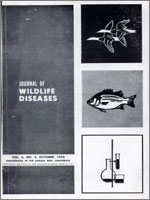Significant reservoirs of trichiniasis in wildlife have been demonstrated only in Iowa and Alaska. Limited findings in other states would indicate, however, that the problem exists in most of the United States. Based on present knowledge, scavenging is probably the primary mode of transmission with predation being of major importance only in the Arctic region where a significant reservoir of the disease is present in the rodent population. Both direct and indirect routes of transmission of the disease from wildlife to man are indicated with the direct route being demonstrated primarily through the ingestion by man of improperly cooked bear meat. The indirect route, wildlife to swine to man, has been demonstrated as a possibility in epidemiological studies in Iowa. An educational program must be developed to alert the hunter, trapper, and swine producer of the significance of wildlife trichiniasis. Studies on the distribution of the disease in the wildlife population of the U.S., the modes of transmission within and between wildlife populations, and means of breaking interrelationships of the wildlife and domestic cycles of the disease are essential to decreasing and eventually eradicating the disease in man and swine.
How to translate text using browser tools
1 October 1970
The Epizootiology of Trichiniasis in Wildlife
W. J. ZIMMERMANN





